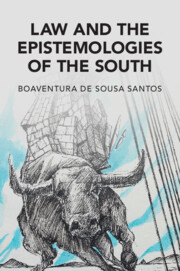137 results
Conclusion
-
- Book:
- Negotiating Legality
- Print publication:
- 27 June 2024, pp 231-237
-
- Chapter
- Export citation
5 - Law and the State
-
-
- Book:
- The Cambridge Comparative History of Ancient Law
- Published online:
- 09 May 2024
- Print publication:
- 30 May 2024, pp 181-230
-
- Chapter
- Export citation
5 - Sustainable Development and the Turn to African Legal Ontologies
- from Part III - Thinking Alternatives
-
- Book:
- Sustainable Development, International Law, and a Turn to African Legal Cosmologies
- Published online:
- 16 May 2024
- Print publication:
- 23 May 2024, pp 201-244
-
- Chapter
- Export citation
5 - Reterritorialising International Law
-
- Book:
- The Rebirth of Territory
- Published online:
- 07 March 2024
- Print publication:
- 14 March 2024, pp 190-248
-
- Chapter
- Export citation
7 - Beyond the State: Can State Law Survive in the Twenty-First Century?
-
-
- Book:
- The Cambridge History of Latin American Law in Global Perspective
- Published online:
- 15 January 2024
- Print publication:
- 08 February 2024, pp 485-541
-
- Chapter
-
- You have access
- Open access
- HTML
- Export citation
3 - All’s Fair in Love and War or the Limits of the Limitations
-
-
- Book:
- Civility, Barbarism and the Evolution of International Humanitarian Law
- Published online:
- 11 January 2024
- Print publication:
- 01 February 2024, pp 34-60
-
- Chapter
- Export citation
14 - Nonprofits as Facilitators of National Self-development
- from Part III - New Directions
-
-
- Book:
- Reimagining Nonprofits
- Published online:
- 11 January 2024
- Print publication:
- 01 February 2024, pp 273-290
-
- Chapter
- Export citation
35 - Comparative Indigenous Law
- from Part IV - Comparative Law beyond the State
-
-
- Book:
- The Cambridge Handbook of Comparative Law
- Published online:
- 26 January 2024
- Print publication:
- 01 February 2024, pp 693-712
-
- Chapter
- Export citation
27 - Legal Pluralism and Commerce
- from Part III - Central Themes in Comparative Law
-
-
- Book:
- The Cambridge Handbook of Comparative Law
- Published online:
- 26 January 2024
- Print publication:
- 01 February 2024, pp 544-558
-
- Chapter
- Export citation
Women seeking justice: claims-making in lower courts in Benin
-
- Journal:
- The Journal of Modern African Studies / Volume 61 / Issue 4 / December 2023
- Published online by Cambridge University Press:
- 29 February 2024, pp. 569-582
- Print publication:
- December 2023
-
- Article
-
- You have access
- Open access
- HTML
- Export citation
Neocolonial Digitality: Analyzing Digital Legal Databases Using Legal Pluralism
-
- Journal:
- Asian Journal of Law and Society / Volume 10 / Issue 3 / October 2023
- Published online by Cambridge University Press:
- 04 October 2023, pp. 516-549
-
- Article
-
- You have access
- Open access
- HTML
- Export citation
8 - Denouements and Turned Spades
-
- Book:
- Thresholds of Accusation
- Published online:
- 14 September 2023
- Print publication:
- 28 September 2023, pp 197-210
-
- Chapter
- Export citation
A theory of legal apparitions: regulation and escape in Indian divorces
-
- Journal:
- International Journal of Law in Context / Volume 19 / Issue 3 / September 2023
- Published online by Cambridge University Press:
- 02 June 2023, pp. 296-314
-
- Article
- Export citation
Eighteen - Decolonising Justice and Democratic Peace in Colombia
- from Part Five - Real Legal Utopias: Interrupting the Law
-
- Book:
- Law and the Epistemologies of the South
- Published online:
- 07 August 2023
- Print publication:
- 01 June 2023, pp 531-558
-
- Chapter
- Export citation
Eleven - The Heterogeneous State, Legal Plurality, and Traditional Authorities in Africa: The Case of Mozambique
- from Part Four - Real Legal Utopias: Interrupting the State
-
- Book:
- Law and the Epistemologies of the South
- Published online:
- 07 August 2023
- Print publication:
- 01 June 2023, pp 295-331
-
- Chapter
- Export citation
Three - The Early Demise of Legal Reformism: My Journey through the Law and Modernisation Program at Yale University
- from Part One - The Tragic Optimism of the Law: THE END OF A STORY
-
- Book:
- Law and the Epistemologies of the South
- Published online:
- 07 August 2023
- Print publication:
- 01 June 2023, pp 38-64
-
- Chapter
- Export citation
Twelve - The Rise of a Micro Dual State: A Case of Highly Politicised Legal Pluralism
- from Part Four - Real Legal Utopias: Interrupting the State
-
-
- Book:
- Law and the Epistemologies of the South
- Published online:
- 07 August 2023
- Print publication:
- 01 June 2023, pp 332-362
-
- Chapter
- Export citation

Law and the Epistemologies of the South
-
- Published online:
- 07 August 2023
- Print publication:
- 01 June 2023
9 - The Normative External Effects of the European Union’s Exercise of Extraterritorial Jurisdiction in Data Protection Law
-
- Book:
- Transatlantic Jurisdictional Conflicts in Data Protection Law
- Published online:
- 06 April 2023
- Print publication:
- 13 April 2023, pp 234-253
-
- Chapter
- Export citation
2 - Legal Pluralism
-
- Book:
- The Asian Law and Society Reader
- Published online:
- 02 March 2023
- Print publication:
- 09 March 2023, pp 74-113
-
- Chapter
- Export citation



